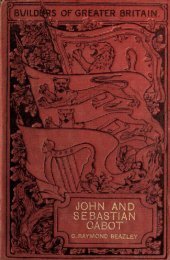2l8 ST. JOHN OF DAMASCUS. king, or, renouncing the throne and embracing the life <strong>of</strong> a hermit, become a Buddha. The great object <strong>of</strong> his father is to prevent this. He therefore keeps the young prince, when he grows up, in his garden and palaces, surrounded by all pleasures which might turn his mind from contemplation to enjoyment. More especially, he is to know nothing <strong>of</strong> illness, old age, and death, which might open his eyes to the misery and unreality <strong>of</strong> life. After a time, however, the prince receives permission to drive out ; and then follow the three drives so famous in Bud dhi<strong>st</strong> hi<strong>st</strong>ory." Without following out the parallel in all its details, it may be added, in brief, that on his fir<strong>st</strong> drive, through the Ea<strong>st</strong>ern gate, the youthful Buddha is met by a decrepit old man, and turns back. On his second drive, through the Southern gate, he is met by a sick man ; on his third through the We<strong>st</strong>ern, by a corpse and on his ; fourth, through the Northern gate, by a religious mendicant, or devotee, whose example he resolves to follow. The towers commemorating these drives are said to have been <strong>st</strong>anding as late as the seventh century. No doubt there are minor discrepancies. Josap hat is described as meeting two men on his fir<strong>st</strong> excur sion, one blind, the other maimed (or, as it is in the Latin version, a leper) ; and as not making any third journey. The monk Barlaam is sent, in<strong>st</strong>ead, to visit him. Still, the general similarity remains. Each ends by converting his royal father, and each dies a saint. And, if it should come to be regarded as certain, that in this "Pr<strong>of</strong>itable Hi<strong>st</strong>ory, brought from the interior region <strong>of</strong> the Ethiopians, called India," we have indeed only another version <strong>of</strong> the Life <strong>of</strong> Buddha, it will furnish matter (as Max Miiller points out) for very in<strong>st</strong>ructive reflection, that Bar laam and Josaphat should have been canonized both in the Ea<strong>st</strong>ern and We<strong>st</strong>ern Church.
ST. JOHN OF DAMASCUS. 2I 9 INDEX, A. ABANA, the, 6 Abd al Malek, 19 Abenner, 188 Abgar, 53 ^Ethiopia, 187 Air, 176 Algebra, 27 n., 167 Ana<strong>st</strong>asius, 58, 60 Annunciation, sermon on the, 125 Aquinas, St. Thomas, indebted to John <strong>of</strong> Damascus, 70, 88 Arabians, the, services <strong>of</strong>, to learning, 67, 166, 184 n. ; early religion <strong>of</strong>, 91 Ari<strong>st</strong>otle, treatises <strong>of</strong>, 67, 210; translations <strong>of</strong>, 68, 169 ; philosophy <strong>of</strong>, 167, 169 ; the De Galoot, 170, 183 Assumption, meaning <strong>of</strong> the term, I3on. ; <strong>st</strong>ory <strong>of</strong> the, 131 ; sermons on the, 129 A<strong>st</strong>rology, 174 B. BAGDAD, 67, 184 Bagradas, the, 179 Barada, the, 6 Barbara, St., 199, 204 Barlaam, the monk, 192 Barlaam and Josaphat, the, 185, 217 Basil, St., 183; quoted, 163 Bible, the, books <strong>of</strong>, 85, 213 ; authorised version <strong>of</strong>, 134, 161 n. ; knowledge <strong>of</strong>, 157 ; <strong>st</strong>udy <strong>of</strong>, 1 80, 213 ; com mentaries on, 1 6 1, 165 Bourgade, Abbe 1 de, 100 Brompton, John <strong>of</strong>, 70 Buddha, Life <strong>of</strong>, 191 n., 217 Bungus, Petrus, 108 CANON, 145 Capita Philosophica^ the, 66 Chabatha, the, 96 Chalcedon, Council <strong>of</strong>, 38 Chaucer, 167, 173, 182 n., 184 n. Chrysorroas, the, 135 Chryso<strong>st</strong>om, St. John, sermon <strong>of</strong> (?), 119; panegyric on, 135; life <strong>of</strong>, 137; quoted, 162, 164; opinions <strong>of</strong>, 171 Church, the Greek, <strong>st</strong>ate <strong>of</strong>, 37, 44; tenets <strong>of</strong>, 75 n., 122 n., 186 ; rites <strong>of</strong>, 80 n. Colet, Dean, 79, 86 n., H5n. Communion, interruption <strong>of</strong> between Ea<strong>st</strong> and We<strong>st</strong>, 44, Con<strong>st</strong>antine Copronymus, 59, 61
- Page 2:
PICTORIALS IUNIVERSITAS
- Page 5:
ST. JOHN OF DAMASCUS.
- Page 8 and 9:
srv. Y J
- Page 10 and 11:
VI PREFACE. subject, the form there
- Page 13 and 14:
ST, JOHN OF DAMASCUS, CHAPTER I. DA
- Page 15 and 16:
" " DAMASCUS. 3 found the
- Page 17 and 18:
" The " DAMASCUS. 5 enmit
- Page 19 and 20:
DAMASCUS. 7 lose themselves, there
- Page 21 and 22:
" " THE MONASTERY OF ST.
- Page 23 and 24:
" A " " " THE M
- Page 25 and 26:
THE MONASTERY OF ST. SABAS. 13 rush
- Page 27 and 28:
" " " THE MAHOMETAN
- Page 29 and 30:
" " THE MAHOMETAN RULE IN
- Page 31 and 32:
" THE MAHOMETAN RULE IN SYRIA.
- Page 33 and 34:
" " " " THE MAH
- Page 35 and 36:
ST. JOHN OF DAMASCUS. 23 CHAPTER IV
- Page 37 and 38:
" JOHN MANSOUR. 25 And as the
- Page 39 and 40:
JOHN MANSOUR. 27 and obtained permi
- Page 41 and 42:
JOHN MANSOUR. 29 emperor himself. L
- Page 43 and 44:
JOHN MANSOUR. 31 expose the vendor
- Page 45 and 46:
" " " JOHN MANSOUR.
- Page 47 and 48:
" JOHN MANSOUR. 35 rne with so
- Page 49 and 50:
" ST. JOHN OF DAMASCUS. 37 CHA
- Page 51 and 52:
1 The THE GREEK CHURCH IN THE EIGHT
- Page 53 and 54:
" " THE GREEK CHURCH IN T
- Page 55 and 56:
THE GREEK CHURCH IN THE EIGHTH CENT
- Page 57 and 58:
THE GREEK CHURCH IN THE EIGHTH CENT
- Page 59 and 60:
THE GREEK CHURCH IN THE EIGHTH CENT
- Page 61 and 62:
THE GREEK CHURCH IN THE EIGHTH CENT
- Page 63 and 64:
ST. JOHN OF DAMASCUS. 51 CHAPTER VI
- Page 65 and 66:
" " " " THE ICO
- Page 67 and 68:
" " " Of " &quo
- Page 69 and 70:
" THE ICONOCLASTIC CONTROVERSY
- Page 71 and 72:
" THE ICONOCLASTIC CONTROVERSY
- Page 73 and 74:
1 " " " " "
- Page 75 and 76:
THE ICONOCLASTIC CONTROVERSY. 63 in
- Page 77 and 78:
" " " " "
- Page 79 and 80:
" On THE "FONS SCIENTLE.&
- Page 81 and 82:
" " " THE "FONS
- Page 83 and 84:
" De " " " THE
- Page 85 and 86:
THE "FONS SCIENTLE." 73 (
- Page 87 and 88:
" " " " "
- Page 89 and 90:
" " THE FONS SCIENTI/E.&q
- Page 91 and 92:
" " " " THE &qu
- Page 93 and 94:
" " " " THE FON
- Page 95 and 96:
" " De " What "
- Page 97 and 98:
" De " THE FONS SCIENTLE.
- Page 99 and 100:
" " Go " THE FONS SC
- Page 101 and 102:
" De De " THE FONS SCIENT
- Page 103 and 104:
" " " What " ON
- Page 105 and 106:
" God " ON THE MAHOMETAN
- Page 107 and 108:
" ON THE MAHOMETAN CONTROVERSY
- Page 109 and 110:
" " " ON THE MAHOMET
- Page 111 and 112:
" ON THE MAHOMETAN CONTROVERSY
- Page 113 and 114:
ON THE MAHOMETAN CONTROVERSY. IOI I
- Page 115 and 116:
" one " " SERMONS. 1
- Page 117 and 118:
SERMONS. IO5 us hold high festival
- Page 119 and 120:
" " " " "
- Page 121 and 122:
" a mountain being the chosen
- Page 123 and 124:
" " SERMONS. 1 1 1 lutely
- Page 125 and 126:
" SERMONS. j j 3 Damascenus ta
- Page 127 and 128:
" He " " SERMONS. 11
- Page 129 and 130:
" Come " " SERMONS.
- Page 131 and 132:
" A " SERMONS. 119 susten
- Page 133 and 134:
" " SERMONS. 121 thee out
- Page 135 and 136:
" " " Of SERMONS. 12
- Page 137 and 138:
SERMONS. 125 divine hands, stretche
- Page 139 and 140:
" " SERMONS. 127 hands, i
- Page 141 and 142:
SERMONS. 129 The first of these exi
- Page 143 and 144:
" 1 The translation which foll
- Page 145 and 146:
" " SERMONS. 133 the kind
- Page 147 and 148:
" SERMONS. 135 eye might fail
- Page 149 and 150:
" SERMONS. 137 light, and has
- Page 151 and 152:
" " " " SERMONS
- Page 153 and 154:
" " " ST. JOHN OF DA
- Page 155 and 156:
HYMNS. 143 When more strictly metri
- Page 157 and 158:
&gt;r the cxixth Psalm be taken
- Page 159 and 160:
" " 1 As HYMNS. 147 and h
- Page 161 and 162:
" HYMNS. 149 called, as being
- Page 163 and 164:
" who HYMNS. To man she turns,
- Page 165 and 166:
HYMNS. 153 But she her Saviour soug
- Page 167 and 168:
&lt;ie cette HYMNS. hymn-writer
- Page 169 and 170:
" COMMENTARIES ON HOLY SCRIPTU
- Page 171 and 172:
" S br " " " CO
- Page 173 and 174:
" COMMENTARIES ON HOLY SCRIPTU
- Page 175 and 176:
than grayness of hair in forming an
- Page 177 and 178:
COMMENTARIES ON HOLY SCRIPTURE. 165
- Page 179 and 180: " ON NATURAL SCIENCE. 167 of o
- Page 181 and 182: " " secular literature. O
- Page 183 and 184: Cifilo," Lib. ii., c . iv. Ari
- Page 185 and 186: " ON NATURAL SCIENCE. 173 Moon
- Page 187 and 188: "Ce que les Arabes aclopterent
- Page 189 and 190: to the Canobic mouth of the Nile, i
- Page 191 and 192: " ON NATURAL SCIENCE. 179 some
- Page 193 and 194: " " " ON NATURAL SCI
- Page 195 and 196: " ON NATURAL SCIENCE. 183 from
- Page 197 and 198: " " ST. JOHN OF DAMASCUS.
- Page 199 and 200: " " " What " &q
- Page 201 and 202: " .s~ DOUBTFUL WRITINGS. S&quo
- Page 203 and 204: 1 For the striking resemblance betw
- Page 205 and 206: " DOUBTFUL WRITINGS. IQ ^ but
- Page 207 and 208: DOUBTFUL WRITINGS. 195 from thee, a
- Page 209 and 210: " " " " "
- Page 211 and 212: " DOUBTFUL WRITINGS. 199 would
- Page 213 and 214: " " " DOUBTFUL WRITI
- Page 215 and 216: ST. JOHN OF DAMASCUS. 20 3 CHAPTER
- Page 217 and 218: " CONCLUSION. instances, we re
- Page 219 and 220: " CONCLUSION. 207 this disposi
- Page 221 and 222: " CONCLUSION. 209 and illitera
- Page 223 and 224: " " " CONCLUSION. 2
- Page 225 and 226: " " " " CONCLUS
- Page 227 and 228: " CONCLUSION. 215 ninth centur
- Page 229: " " " APPENDIX, P. I
- Page 233 and 234: 85, Hymns, meaning of the term, 141
- Page 235: INDEX. 22 3 T. TABOR, mount, 104 Te
- Page 238 and 239: si PUBLICATIONS OF THE SOCIETY NON-
- Page 240: PUBLICATIONS OF THE SOCIETY. CONVER
















